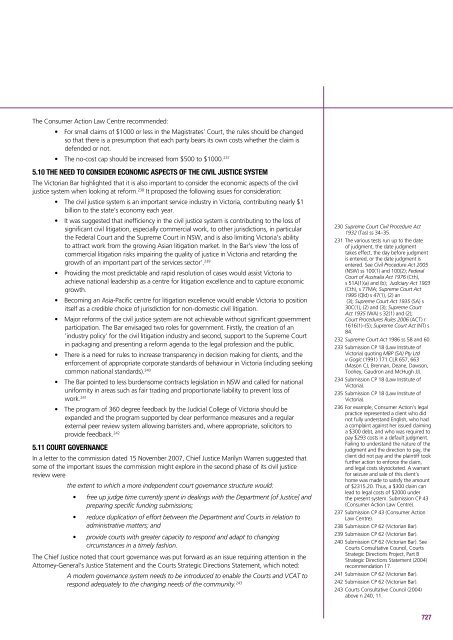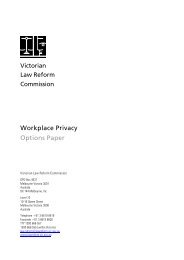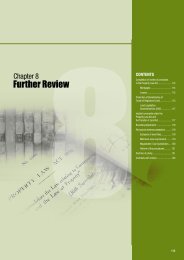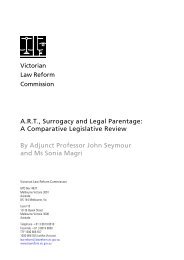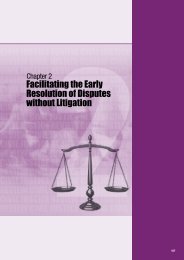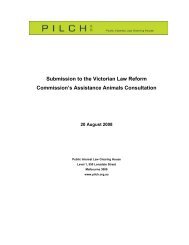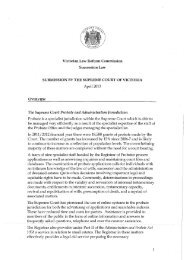12Facilitating Ongoing Civil Justice Review and Reform
12Facilitating Ongoing Civil Justice Review and Reform
12Facilitating Ongoing Civil Justice Review and Reform
You also want an ePaper? Increase the reach of your titles
YUMPU automatically turns print PDFs into web optimized ePapers that Google loves.
The Consumer Action Law Centre recommended:<br />
• For small claims of $1000 or less in the Magistrates’ Court, the rules should be changed<br />
so that there is a presumption that each party bears its own costs whether the claim is<br />
defended or not.<br />
237<br />
• The no-cost cap should be increased from $500 to $1000.<br />
5.10 the Need to consider economic aspects of the civil justice system<br />
The Victorian Bar highlighted that it is also important to consider the economic aspects of the civil<br />
justice system when looking at reform. 238 It proposed the following issues for consideration:<br />
• The civil justice system is an important service industry in Victoria, contributing nearly $1<br />
billion to the state’s economy each year.<br />
• It was suggested that inefficiency in the civil justice system is contributing to the loss of<br />
significant civil litigation, especially commercial work, to other jurisdictions, in particular<br />
the Federal Court <strong>and</strong> the Supreme Court in NSW, <strong>and</strong> is also limiting Victoria’s ability<br />
to attract work from the growing Asian litigation market. In the Bar’s view ‘the loss of<br />
commercial litigation risks impairing the quality of justice in Victoria <strong>and</strong> retarding the<br />
growth of an important part of the services sector’. 239<br />
• Providing the most predictable <strong>and</strong> rapid resolution of cases would assist Victoria to<br />
achieve national leadership as a centre for litigation excellence <strong>and</strong> to capture economic<br />
growth.<br />
• Becoming an Asia-Pacific centre for litigation excellence would enable Victoria to position<br />
itself as a credible choice of jurisdiction for non-domestic civil litigation.<br />
• Major reforms of the civil justice system are not achievable without significant government<br />
participation. The Bar envisaged two roles for government. Firstly, the creation of an<br />
‘industry policy’ for the civil litigation industry <strong>and</strong> second, support to the Supreme Court<br />
in packaging <strong>and</strong> presenting a reform agenda to the legal profession <strong>and</strong> the public.<br />
• There is a need for rules to increase transparency in decision making for clients, <strong>and</strong> the<br />
enforcement of appropriate corporate st<strong>and</strong>ards of behaviour in Victoria (including seeking<br />
common national st<strong>and</strong>ards). 240<br />
• The Bar pointed to less burdensome contracts legislation in NSW <strong>and</strong> called for national<br />
uniformity in areas such as fair trading <strong>and</strong> proportionate liability to prevent loss of<br />
work. 241<br />
• The program of 360 degree feedback by the Judicial College of Victoria should be<br />
exp<strong>and</strong>ed <strong>and</strong> the program supported by clear performance measures <strong>and</strong> a regular<br />
external peer review system allowing barristers <strong>and</strong>, where appropriate, solicitors to<br />
provide feedback. 242<br />
5.11 Court governance<br />
In a letter to the commission dated 15 November 2007, Chief <strong>Justice</strong> Marilyn Warren suggested that<br />
some of the important issues the commission might explore in the second phase of its civil justice<br />
review were<br />
the extent to which a more independent court governance structure would:<br />
• free up judge time currently spent in dealings with the Department [of <strong>Justice</strong>] <strong>and</strong><br />
preparing specific funding submissions;<br />
• reduce duplication of effort between the Department <strong>and</strong> Courts in relation to<br />
administrative matters; <strong>and</strong><br />
• provide courts with greater capacity to respond <strong>and</strong> adapt to changing<br />
circumstances in a timely fashion.<br />
The Chief <strong>Justice</strong> noted that court governance was put forward as an issue requiring attention in the<br />
Attorney-General’s <strong>Justice</strong> Statement <strong>and</strong> the Courts Strategic Directions Statement, which noted:<br />
A modern governance system needs to be introduced to enable the Courts <strong>and</strong> VCAT to<br />
respond adequately to the changing needs of the community. 243<br />
230 Supreme Court <strong>Civil</strong> Procedure Act<br />
1932 (Tas) ss 34–35.<br />
231 The various tests run up to the date<br />
of judgment, the date judgment<br />
takes effect, the day before judgment<br />
is entered, or the date judgment is<br />
entered. See <strong>Civil</strong> Procedure Act 2005<br />
(NSW) ss 100(1) <strong>and</strong> 100(2); Federal<br />
Court of Australia Act 1976 (Cth),<br />
s 51A(1)(a) <strong>and</strong> (b); Judiciary Act 1903<br />
(Cth), s 77MA; Supreme Court Act<br />
1995 (Qld) s 47(1), (2) an<br />
(3); Supreme Court Act 1935 (SA) s<br />
30C(1), (2) <strong>and</strong> (3); Supreme Court<br />
Act 1935 (WA) s 32(1) <strong>and</strong> (2);<br />
Court Procedures Rules 2006 (ACT) r<br />
1616(1)–(5); Supreme Court Act (NT) s<br />
84.<br />
232 Supreme Court Act 1986 ss 58 <strong>and</strong> 60.<br />
233 Submission CP 18 (Law Institute of<br />
Victoria) quoting MBP (SA) Pty Ltd<br />
v Gogic (1991) 171 CLR 657, 663<br />
(Mason CJ, Brennan, Deane, Dawson,<br />
Toohey, Gaudron <strong>and</strong> McHugh JJ).<br />
234 Submission CP 18 (Law Institute of<br />
Victoria).<br />
235 Submission CP 18 (Law Institute of<br />
Victoria).<br />
236 For example, Consumer Action’s legal<br />
practice represented a client who did<br />
not fully underst<strong>and</strong> English, who had<br />
a complaint against her issued claiming<br />
a $300 debt, <strong>and</strong> who was required to<br />
pay $293 costs in a default judgment.<br />
Failing to underst<strong>and</strong> the nature of the<br />
judgment <strong>and</strong> the direction to pay, the<br />
client did not pay <strong>and</strong> the plaintiff took<br />
further action to enforce the claim,<br />
<strong>and</strong> legal costs skyrocketed. A warrant<br />
for seizure <strong>and</strong> sale of this client’s<br />
home was made to satisfy the amount<br />
of $2315.20. Thus, a $300 claim can<br />
lead to legal costs of $2000 under<br />
the present system. Submission CP 43<br />
(Consumer Action Law Centre).<br />
237 Submission CP 43 (Consumer Action<br />
Law Centre).<br />
238 Submission CP 62 (Victorian Bar).<br />
239 Submission CP 62 (Victorian Bar).<br />
240 Submission CP 62 (Victorian Bar). See<br />
Courts Consultative Council, Courts<br />
Strategic Directions Project, Part B<br />
Strategic Directions Statement (2004)<br />
recommendation 17.<br />
241 Submission CP 62 (Victorian Bar).<br />
242 Submission CP 62 (Victorian Bar).<br />
243 Courts Consultative Council (2004)<br />
above n 240, 11.<br />
727


